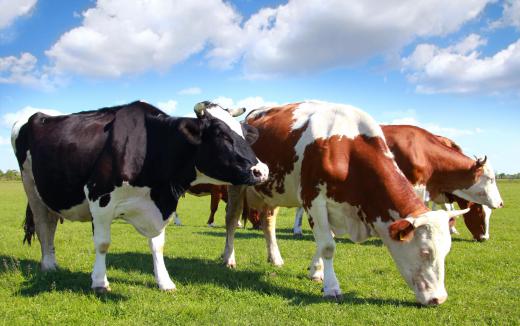What is a Biogas Digester?
 Mary McMahon
Mary McMahon
A biogas digester, also known as a methane digester, is a piece of equipment which can turn organic waste into usable fuel. In addition to providing a source of renewable fuel, biogas digesters also provide low-cost fuel to people in poverty, and they help to dispose of waste materials which would otherwise be discarded. A number of nations have invested in research on biogas digesters, ranging from devices which can be used by a single household to industrial-scale equipment which could be used to generate large amounts of power.
The biogas digester relies on bacterial decomposition of biomass, waste material which is biological in origin, ranging from kitchen scraps to cow dung. As anyone who has walked past a poorly maintained outhouse or compost pile is aware, when anaerobic conditions develop in a collection of biomass, they attract bacterial organisms which emit a number of distinctive gases, most notably methane, in the process of digestion. These gases are usually viewed as a symptom of inefficiency and they are vented away for disposal, but they can actually be very useful.

In a biogas digester, anaerobic digestion and fermentation is actually encouraged, and the gases are vented to a storage container. The resulting biogas can be burned as fuel for cooking, heating, and electricity generation. The sludge which remains in the biogas digester after the fermentation process is complete can be used for fertilizer. Because the process harnessed in a biogas digester is anaerobic in nature, these devices are sometimes known as anaerobic digesters.
One of the major applications for biogas digesters is in the disposal of human and farm waste. In many developing nations, controlling human waste is a major issue, and so is the availability of energy. By providing communities with biogas digesters, organizations and the government could help contribute to improvements in public health while also providing communities with a source of sustainable energy. Farms, which can generate large volumes of animal waste, can also utilize biogas disgesters to power their operations or to generate power which can be traded or sold.
Advocates for sustainable energy have promoted the biogas digester as one option which could be used to reduce reliance on fossil fuels. In addition to providing sustainable energy, biogas digesters are also low cost, efficient, and easy to maintain. This makes them an excellent tool for organizations which attempt to empower communities by providing them with tools they can maintain and use themselves, rather than just giving aid, which can cause communities to become dependent on outside assistance.
AS FEATURED ON:
AS FEATURED ON:











Discussion Comments
yes, kitchen refuse can be used. As a matter of fact, it is used in most developed areas. Any biodegradable material can be used to generate this gas, but the percentage of the methane gas differs depending on what material you use.
Plantain peel and poultry waste can also generate gas.
can we use kitchen refuse instead?
what else can you use apart from cow dung?
Post your comments